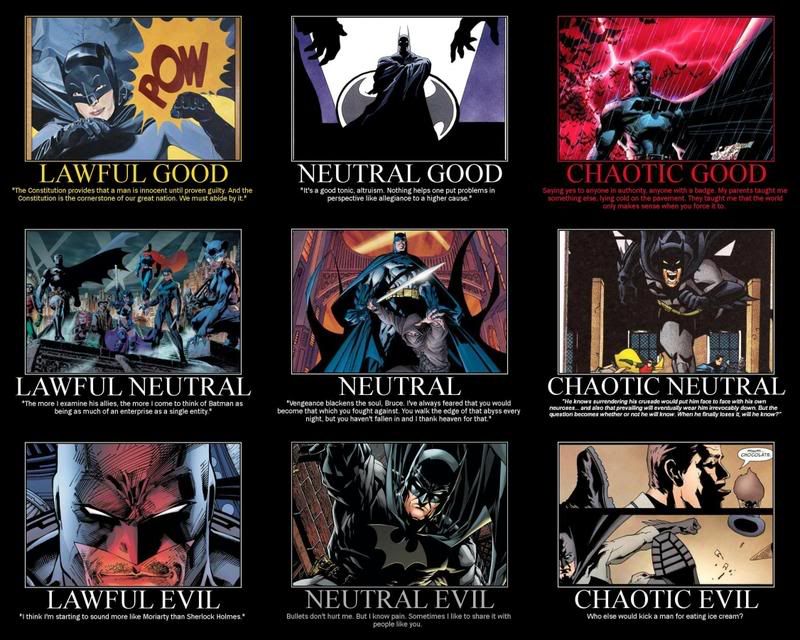I like some restrictions but not all.
Assassin - must be Evil; I'm cool with this.
I'd prefer that they are required to be nongood, personally. I'm cool with morally gray assassins alongside morally dark ones. In fact, I'd say that's a
stronger archetype.
Barbarian - should not even be a class.
I kind of agree with you on this one, but many people feel differently (including the designers).
Bard - should be able to be any.
Logical. After all, the original bards were also usually keepers of tradition and ancient laws, which fits into the traditionally prohibited lawful alignments.
Druid - should be able to be any; just like Clerics and for much the same reasons.
I kind of like the "must be some kind of neutral" alignment restriction, but I'll admit it can come off as metagame-y. I think that
if you're going to have druids as a separate class from clerics than druids shouldn't be required to worship deities - therefore no alignment by deity restrictions.
Monk - must be Lawful; I'm cool with this.
It seems logical on the surface, but the Sith = CE monks is to me a persuasive argument. Besides, when it comes down to it, monks are really just based on kung fu action heroes, which, as often as not, fit into the lone wandered apart from society that was once used to justify bards as a solely
non-lawful class. So I'd say let them be any alignment if you're going to have any restrictions at all.
Paladin/Cavalier/Knight - any Lawful or any Good, this allows for "black knights" and somewhat-chaotic freelance types.
This falls into the unfortunate trap, however, of defining law and good as more or less the same thing. Why should a paladin be allowed to be lawful
or good? If we're going to water down the paladin's traditional alignment restraint but not turn them into "martial paragons of a particular deity" archetype, then it makes more sense to require them to be lawful or to require them to be good, but not make it an either/or arrangement.
Otherwise, you're basically just saying that law = good and therefore
all paladins are just a subset of lawful good.
Ranger - should be able to be any.
I'm cool with this.
Thief/Rogue - should be able to be anything except Lawful Good.
Rogues are difficult because they've never had a clear archetypes. Thieves, I can see being chaotic or nonlawful by default. But spies? Or diplomats? Or acrobats? All of these are archetypes that have been picked up by rogues at one point or another and all come with their own implied alignment range. So, unless they're going to narrow down the definition of the rogue, I'd say leave them as available to any alignment.
Warlock - like Cleric, must be the same as its power source.
I have a bit of a problem with this because, really, warlocks don't
worship the being they form a pact with - they're just making a deal in exchange for power. It means no more or no less to a warlock than any other person under contract to any other kind of authority - they don't necessarily believe in the being's cause or idolize them. Hell, the warlock may even
dislike their pact giver.
Plus, it makes pacts mutually exclusive, which I don't really like. Powerful warlocks should be able to make pacts with several different kind of beings, like Ammon Jerro in
Neverwinter Nights 2: demons, devils, fey, aberrations, whatever. But by this rule a demonic pact and a diabolic one would be mutually exclusive. Again, the warlock doesn't is devoted to their pact giver, they're merely under contract.
However, clerics actually only have to be within
one step of their deity's alignment. So that might be more palatable and I do understand the desire to prevent CG characters from making a deal with the devil as one example.
Illusionist - I could quickly buy into these being forced to non-Lawful, if only for purely flavour reasons.
Seems unnecessary really. Many real illusionists could qualify as lawful, IMO.
Necromancer - must be Evil.
Depends on the setting's view of necromancy. Sure, you're defiling a body, but if you're doing no harm to the immortal soul than why would it be evil? In Planescape, for example, the dustmen are canonically neutral in alignment but they routinely use undead creatures like zombies. It's viewed by many as
disturbing but not particularly evil, generally speaking.
Holy long thread, Batman!
(Maybe we should discuss what alignment he is?)
Depends on the writer.



